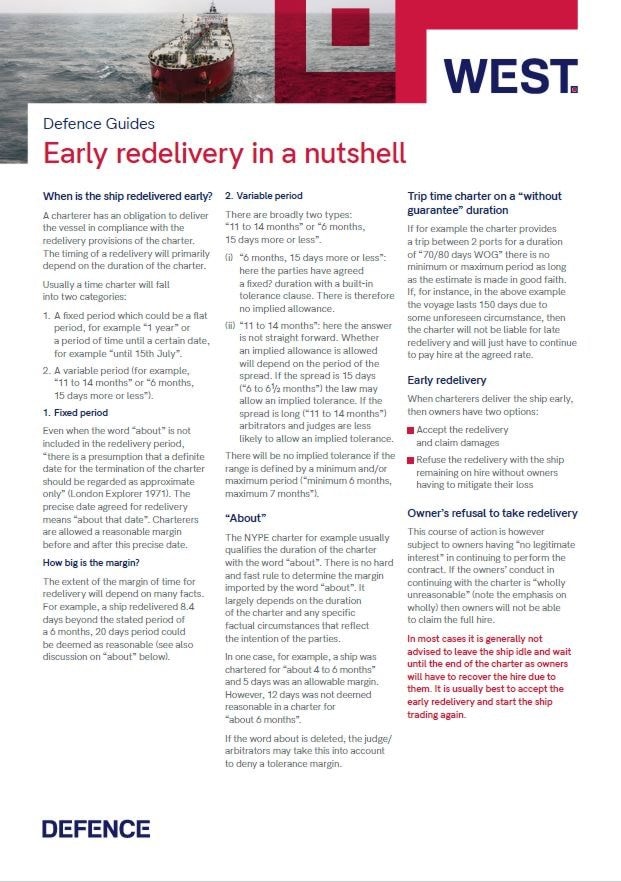
Defence Guide
28 Mar, 2022
Defence Guide - Early redelivery in a nutshell
When is the ship redelivered early?
A charterer has an obligation to deliver the vessel in compliance with the redelivery provisions of the charter. The timing of a redelivery will primarily
depend on the duration of the charter.
Usually a time charter will fall into two categories:
1. A fixed period which could be a flat period, for example “1 year” or a period of time until a certain date, for example “until 15th July”.
2. A variable period (for example, “11 to 14 months” or “6 months, 15 days more or less”).
1. Fixed period
Even when the word “about” is not included in the redelivery period, “there is a presumption that a definite date for the termination of the charter should be regarded as approximate
only” (London Explorer 1971). The precise date agreed for redelivery means “about that date”. Charterers are allowed a reasonable margin
before and after this precise date.
How big is the margin?
The extent of the margin of time for redelivery will depend on many facts. For example, a ship redelivered 8.4 days beyond the stated period of a 6 months, 20 days period could be deemed as reasonable (see also discussion on “about” below).
2. Variable period
There are broadly two types:
“11 to 14 months” or “6 months, 15 days more or less”.
(i) “6 months, 15 days more or less”: here the parties have agreed a fixed? duration with a built-in tolerance clause. There is therefore no implied allowance.
(ii) “11 to 14 months”: here the answer is not straight forward. Whether an implied allowance is allowed will depend on the period of the spread. If the spread is 15 days (“6 to 61/2 months”) the law may allow an implied tolerance. If the spread is long (“11 to 14 months”) arbitrators and judges are less likely to allow an implied tolerance.
There will be no implied tolerance if the range is defined by a minimum and/or maximum period (“minimum 6 months, maximum 7 months”).
“About”
The NYPE charter for example usually qualifies the duration of the charter with the word “about”. There is no hard and fast rule to determine the margin imported by the word “about”. It largely depends on the duration of the charter and any specific factual circumstances that reflect the intention of the parties.
In one case, for example, a ship was chartered for “about 4 to 6 months” and 5 days was an allowable margin. However, 12 days was not deemed reasonable in a charter for “about 6 months”.
If the word about is deleted, the judge/arbitrators may take this into account to deny a tolerance margin.
Trip time charter on a “without guarantee” duration
If for example the charter provides a trip between 2 ports for a duration
of “70/80 days WOG” there is no minimum or maximum period as long
as the estimate is made in good faith. If, for instance, in the above example the voyage lasts 150 days due to some unforeseen circumstance, then the charter will not be liable for late redelivery and will just have to continue to pay hire at the agreed rate.
Early redelivery
When charterers deliver the ship early, then owners have two options:
- Accept the redelivery and claim damages
- Refuse the redelivery with the ship remaining on hire without owners having to mitigate their loss
Owner’s refusal to take redelivery
This course of action is however subject to owners having “no legitimate interest” in continuing to perform the contract. If the owners’ conduct in continuing with the charter is “wholly unreasonable” (note the emphasis on
wholly) then owners will not be able to claim the full hire.
In most cases it is generally not advised to leave the ship idle and wait until the end of the charter as owners will have to recover the hire due to them. It is usually best to accept the
early redelivery and start the ship trading again.
What is a “wholly unreasonable”?
Owners’ mere unreasonable behaviour
will not be sufficient. It must be “wholly”
unreasonable. What is considered to
be wholly unreasonable will depend on
circumstances. If the ship is redelivered
10 days early, it is very likely that the
owner will be able to refuse redelivery
of the ship and insist that hire is paid
until the minimum redelivery date.
If however the redelivery date is 2
years early there probably would be
no “legitimate interest” in owners
insisting on charterers continuing to
perform the charter.
How much damages may the
owner recover?
The general rule is that owners
will be able to claim the difference
between the charter rate and the
“available market” rate if the ship had
been promptly re-chartered for the
remainder of the charter period.
(C/P rate – Available Market rate) x
days redelivered early = damages.
What constitutes the “available
market” rate?
The “available market” rate will be
determined by reference to the same
market as the original charter i.e. the
same geographical area, trade and for
a charter period corresponding to the
remainder of the original charter.
If a ship was chartered for 12 months
on the Atlantic trade and redelivered
after 7 months, then the relevant
market would be for a 5 months charter
(the remainder of the original charter) in
the Atlantic trade.
What if owners re-charter on a different market?
Taking the above example, what if the owners decide to relocate the ship from the Atlantic to the Asia trade? There is nothing stopping owners from doing so, albeit at their own risk. If the owner ends up earning less hire in Asia than
he would have done in the Atlantic, then the damages will still be based on the “available market” rate. Owners will not be able to claim the difference between the available market and the different market.
What if the owner finds a different market better paid than the “available market”?
The fact that owners have suffered fewer losses than under the available market is not relevant. The loss will still be calculated by reference to the “available market”. The owner could potentially make a profit and still claim
for losses against the charterer.
What if there is no available
market?
In such circumstances, owners will be entitled to such sums as would put them in the same financial position as if the charter had been performed.
What if an event permitting termination of the original charter occurs after redelivery but before the end of the minimum period?
In a situation where an event occurs (after redelivery but before the end of the minimum period) which would have meant that the charterers could have terminated the charter early (war, etc…), the owners will only be able to
claim damages up to the date of the event which would have triggered the termination of the contract.
Taking the previous example (12 months C/P redelivered after 7 months), if an event permitting the termination of the charter occurred on the 9th month, then owners would
only be able to claim damages for a 2 months period instead of 5 months.
-
Early redelivery in a nutshell PDF (168.2 KB)
June 2015
This article was written by Julien Rabeux in the Club’s Hong Kong office with additional input from Ince & Co (Hong Kong).
This note is for general guidance only and should not be relied upon as legal advice.
Should you require specific advice on a
particular situation please contact the Club.

